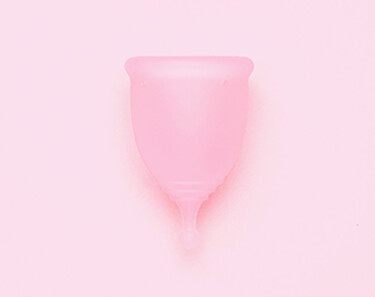The menstrual cup: an alternative to classic forms of hygienic protection

The menstrual cup (or cup) is winning over more and more women. Economical, environmentally-friendly, comfortable – there is a host of arguments for this form of hygienic protection.
What is the menstrual cup?
The menstrual cup is an alternative to classic forms of hygienic protection. It comes in the form of a silicone receptacle, which is inserted into the vagina to collect menstrual blood. The menstrual cup is supple, malleable, fits the shape of the vagina and adapts perfectly to movement.
The advantages of the menstrual cup
Fans of the menstrual cup cite several advantages of this hygienic protection, which were first listed in 1960 in a scientific study1: it is practical and economical, with its cost quickly recouped much more quickly than other forms of protection, and is environmentally-friendly, lasting an average of five years.
How do you insert a menstrual cup?
Firstly, it is recommended that you practise inserting it before your period, using a lubricant if needed.
You should rinse it every time you use it, and sterilise it at the end of your period by boiling it for 5 minutes, or heating in the microwave for 3 minutes at 700w in its sterilisation box.
As inserting the cup is a delicate operation, you should take your time and get comfortable first: fold the receptacle side of the cup and insert it into the vagina, holding your labia apart, then slowly let go and allow it to expand. Ensure that it is fully open by moving a finger around the edge.
How do you sterilise a menstrual cup?
It is important to sterilise your cup before the first use and between every use, with the sterilisation box. You should position the menstrual cup in an upwards position, with the stem pointing downwards, inside the box, immersing it in water. The lid should remain open, by positioning it perpendicular to the box compared to the usual closed position.
Place in the microwave for 3 minutes at 700 watts.
Take the sterilisation box out of the microwave and leave the cup to dry inside the box, positioned upside down. Take care not to burn yourself when taking it out.
How do you remove a menstrual cup?
Place your thumb and index finger inside your vagina to locate the stem or textured base of the cup. Gently pinch the base to release the suction effect and gently slip out the cup. Do not pull on the stem to remove the cup.
When you have completely removed the cup, hold it upwards and empty it into the toilet. Do not forget to rinse it with warm water before reinserting it.
The disadvantages of the menstrual cup
You always need to have something to rinse it with after use and before reuse, or have a second, clean cup with you,
You need to not be bothered by the sight of blood, as you have to handle blood every time you empty or rinse it,
The menstrual cup may change colour over time.
A few notes and cautions
- Do not wear Saforelle CUP during the night. It is recommended that you wear a Saforelle sanitary towel at night.
- Do not wear Saforelle CUP outside your period.
- Saforelle CUP should be removed at the end of your period.
- Saforelle Cup CUP is not a contraceptive.
- If you wear a contraceptive such as a coil or vaginal ring, ask your doctor for advice before using Saforelle CUP.
- Saforelle CUP does not protect you against sexually transmitted diseases (STD).
- Remove Saforelle CUP before sexual intercourse.
- After giving birth, surgery, a miscarriage or termination, wait for your vagina to recover before using Saforelle CUP.
- In the event of a vaginal infection, pessary-based treatment or the use of any other intravaginal cream, it is recommended that you use a Saforelle sanitary towel during this period.
- In the event of irritation, burning sensations, urinary discomfort or pain, cease use immediately and contact your doctor.
- Saforelle CUP is reserved for personal use.
- Keep Saforelle CUP out of the reach of children.
Information on Toxic Shock Syndrome (TSS)
TSS is a rare but dangerous infection caused by toxins of bacterial origin (Staphylococcus aureus) usually found on the skin and in the nose. This infection can affect men, women and children, but the risk of contracting TSS is higher in teenagers and women under 30 years of age. Though rare, it is important to know what the symptoms are so that you can take action if necessary. It is also crucial to be able to recognise the first signs of TSS so that you can treat it from the outset.
The symptoms of toxic shock are as follows: high temperature of sudden onset (39° or higher), nausea, vomiting, loss of consciousness, diarrhea, muscle pain, throat pain, skin rash similar to sunburn.
Only some of these symptoms may appear. Left untreated, TSS can cause serious infection with fatal consequences. If you notice one of these symptoms, remove your cup immediately and consult a doctor. You should tell him/her that you have used a cup. Speak to your doctor before reusing a cup.
To reduce the risk of contracting TSS, empty the cup a maximum of every 6 hours. You can also use a Saforelle sanitary towel at least once a day and during the night. If you do not use a cup, the risk of contracting TSS is reduced but cannot be ruled out.
1 Karl John Karnaky, Obstetrics and Gynecology. Internal Menstrual Protection with the Rubber Menstrual Cup. http://coupemenstruelle.net/wp-content/uploads/2016/07/Menstrual-Cup-Scientific-research.pdf

JULIANE BERDAH
Medical and obstetric Gynaecologis


